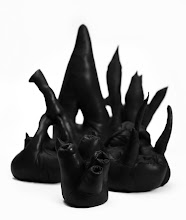

Phew. I made it! I handed in my exegesis last week of April. After many all-nighters in the studio, wrestling with Word formatting and nasty online thesauruses, I can now see that 85page tome as a work of beauty and fulfillment. Now wracking brain and body to make installation tables and hanging devices. So much for the work being autonomous, all the props deserve a thesis of their own. But I am so looking forward to having the things out in the big wide white cube, so if in Darwin please come and see.
ABSTRACT:
This research project investigates the concept of human intimacy with the natural environment. I consider my personal experience as an archetype of the chronic contemporary condition, that of an urban dweller looking out from the modern comforts of the domestic and global culture to reconcile my existence within nature.
My move from Melbourne to living amidst the prevailing wildlife of tropical Darwin has honed my fascination for organic processes. This however is a socially critical perspective, reflecting the cultural implications of perceiving the natural world.
In the context of this research, I relate my artistic approach to a ‘homemaker’- one defined by the security of the familiar - trying to find their way in the ‘Wilderness’. This is a perceived primordial space beyond civilisation where the forces of nature threaten harshness and danger as much as they are the source of fecund wild beauty and truth. The title is a reference to my concern with an anthropocentric approach to the natural environment as much as a metaphor for the exploratory practice-led methodology.
My studio investigations function as a process of representation, from pseudo-scientific fieldwork to sculpture as experiential simulations of wonder for the natural form. The resulting body of work primarily uses black leather, hand stitched into soft sculptures. This visual language retains the vocabulary of the domestic and cultivated - the crafted form, soft toys and furnishings - whereas the materiality of leather takes on a bestial quality suggesting the body and evocative of skin. The physical form of the sculptures are modeled on nature observations - such as plant structures, termite mounds and mangrove root systems, but signify universal life forms of organic growth and decay. The rendering of natural form as something familiar and resembling one’s own body makes for a sensation of simulated intimacy.
In considering how my work is read by a viewer, I draw on the Phenomenological notion of the ‘lived body’, in particular Merleau-Ponty’s concept of ‘flesh’, where the flesh of the body is how we know the flesh of the world.
